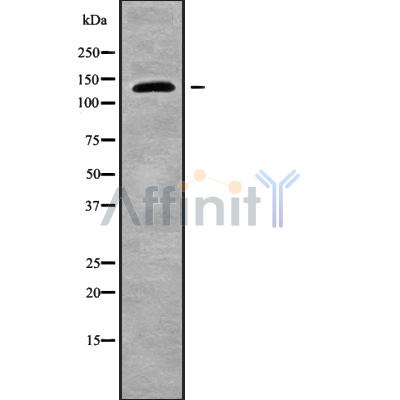HCN4 Antibody - #DF9771
| Product: | HCN4 Antibody |
| Catalog: | DF9771 |
| Description: | Rabbit polyclonal antibody to HCN4 |
| Application: | WB IHC |
| Reactivity: | Human, Mouse, Rat, Monkey |
| Prediction: | Pig, Bovine, Rabbit |
| Mol.Wt.: | 129 kDa; 129kD(Calculated). |
| Uniprot: | Q9Y3Q4 |
| RRID: | AB_2842966 |
Related Downloads
Protocols
Product Info
*The optimal dilutions should be determined by the end user. For optimal experimental results, antibody reuse is not recommended.
*Tips:
WB: For western blot detection of denatured protein samples. IHC: For immunohistochemical detection of paraffin sections (IHC-p) or frozen sections (IHC-f) of tissue samples. IF/ICC: For immunofluorescence detection of cell samples. ELISA(peptide): For ELISA detection of antigenic peptide.
Cite Format: Affinity Biosciences Cat# DF9771, RRID:AB_2842966.
Fold/Unfold
HCN 4; Hyperpolarization activated cyclic nucleotide gated potassium channel 4; Potassium/sodium hyperpolarization activated cyclic nucleotide gated channel 4;
Immunogens
A synthesized peptide derived from human HCN4
Highly expressed in thalamus, testis and in heart, both in ventricle and atrium. Detected at much lower levels in amygdala, substantia nigra, cerebellum and hippocampus.
- Q9Y3Q4 HCN4_HUMAN:
- Protein BLAST With
- NCBI/
- ExPASy/
- Uniprot
MDKLPPSMRKRLYSLPQQVGAKAWIMDEEEDAEEEGAGGRQDPSRRSIRLRPLPSPSPSAAAGGTESRSSALGAADSEGPARGAGKSSTNGDCRRFRGSLASLGSRGGGSGGTGSGSSHGHLHDSAEERRLIAEGDASPGEDRTPPGLAAEPERPGASAQPAASPPPPQQPPQPASASCEQPSVDTAIKVEGGAAAGDQILPEAEVRLGQAGFMQRQFGAMLQPGVNKFSLRMFGSQKAVEREQERVKSAGFWIIHPYSDFRFYWDLTMLLLMVGNLIIIPVGITFFKDENTTPWIVFNVVSDTFFLIDLVLNFRTGIVVEDNTEIILDPQRIKMKYLKSWFMVDFISSIPVDYIFLIVETRIDSEVYKTARALRIVRFTKILSLLRLLRLSRLIRYIHQWEEIFHMTYDLASAVVRIVNLIGMMLLLCHWDGCLQFLVPMLQDFPDDCWVSINNMVNNSWGKQYSYALFKAMSHMLCIGYGRQAPVGMSDVWLTMLSMIVGATCYAMFIGHATALIQSLDSSRRQYQEKYKQVEQYMSFHKLPPDTRQRIHDYYEHRYQGKMFDEESILGELSEPLREEIINFNCRKLVASMPLFANADPNFVTSMLTKLRFEVFQPGDYIIREGTIGKKMYFIQHGVVSVLTKGNKETKLADGSYFGEICLLTRGRRTASVRADTYCRLYSLSVDNFNEVLEEYPMMRRAFETVALDRLDRIGKKNSILLHKVQHDLNSGVFNYQENEIIQQIVQHDREMAHCAHRVQAAASATPTPTPVIWTPLIQAPLQAAAATTSVAIALTHHPRLPAAIFRPPPGSGLGNLGAGQTPRHLKRLQSLIPSALGSASPASSPSQVDTPSSSSFHIQQLAGFSAPAGLSPLLPSSSSSPPPGACGSPSAPTPSAGVAATTIAGFGHFHKALGGSLSSSDSPLLTPLQPGARSPQAAQPSPAPPGARGGLGLPEHFLPPPPSSRSPSSSPGQLGQPPGELSLGLATGPLSTPETPPRQPEPPSLVAGASGGASPVGFTPRGGLSPPGHSPGPPRTFPSAPPRASGSHGSLLLPPASSPPPPQVPQRRGTPPLTPGRLTQDLKLISASQPALPQDGAQTLRRASPHSSGESMAAFPLFPRAGGGSGGSGSSGGLGPPGRPYGAIPGQHVTLPRKTSSGSLPPPLSLFGARATSSGGPPLTAGPQREPGARPEPVRSKLPSNL
Predictions
Score>80(red) has high confidence and is suggested to be used for WB detection. *The prediction model is mainly based on the alignment of immunogen sequences, the results are for reference only, not as the basis of quality assurance.
High(score>80) Medium(80>score>50) Low(score<50) No confidence
Research Backgrounds
Hyperpolarization-activated ion channel with very slow activation and inactivation exhibiting weak selectivity for potassium over sodium ions. Contributes to the native pacemaker currents in heart (If) that regulate the rhythm of heart beat. May contribute to the native pacemaker currents in neurons (Ih). May mediate responses to sour stimuli.
Cell membrane>Multi-pass membrane protein.
Highly expressed in thalamus, testis and in heart, both in ventricle and atrium. Detected at much lower levels in amygdala, substantia nigra, cerebellum and hippocampus.
The segment S4 is probably the voltage-sensor and is characterized by a series of positively charged amino acids at every third position.
Belongs to the potassium channel HCN family.
Research Fields
· Environmental Information Processing > Signal transduction > cAMP signaling pathway. (View pathway)
· Organismal Systems > Sensory system > Taste transduction.
References
Restrictive clause
Affinity Biosciences tests all products strictly. Citations are provided as a resource for additional applications that have not been validated by Affinity Biosciences. Please choose the appropriate format for each application and consult Materials and Methods sections for additional details about the use of any product in these publications.
For Research Use Only.
Not for use in diagnostic or therapeutic procedures. Not for resale. Not for distribution without written consent. Affinity Biosciences will not be held responsible for patent infringement or other violations that may occur with the use of our products. Affinity Biosciences, Affinity Biosciences Logo and all other trademarks are the property of Affinity Biosciences LTD.

